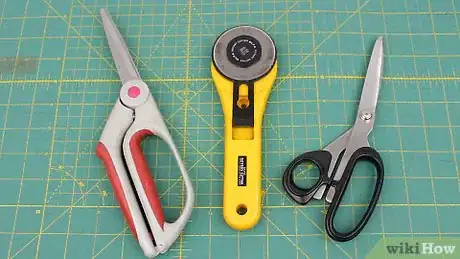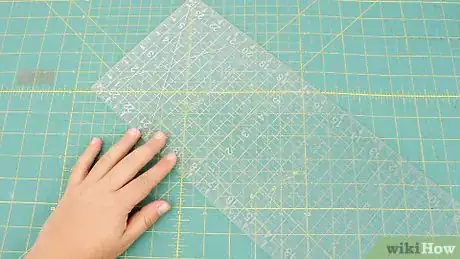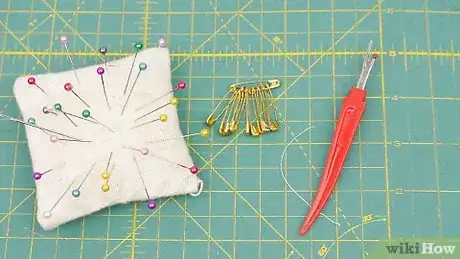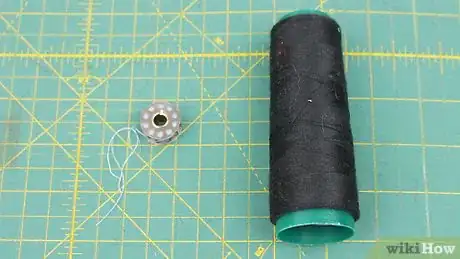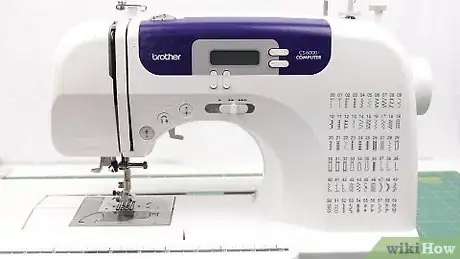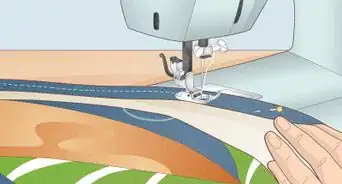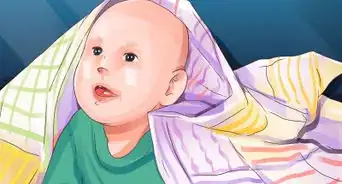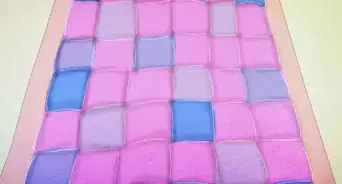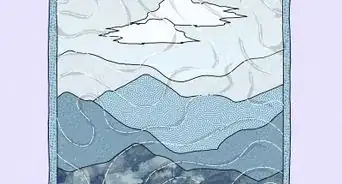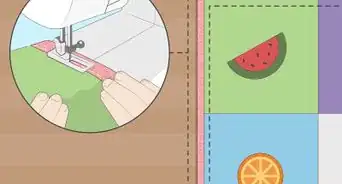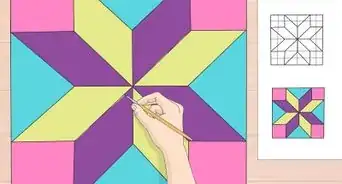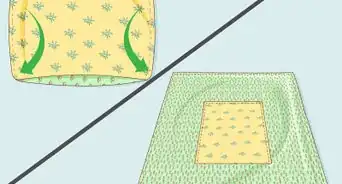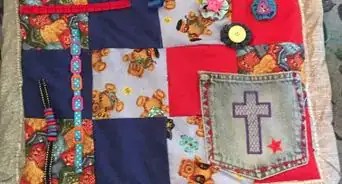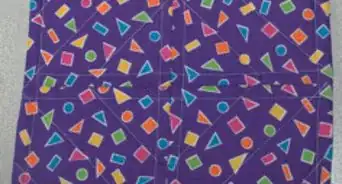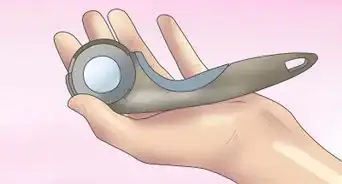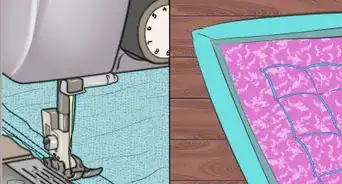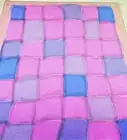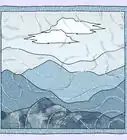This article was co-authored by Sarah Stearns. Sarah Stearns is a DIY Specialist, Artist, Maker, Blogger, and the Founder of SarahMaker.com. With over ten years of experience, she specializes in fun, approachable crafts like crocheting, making polymer clay jewelry, quilting, and creating Cricut projects. Her work has been featured in several publications, such as Scientific American, Good Housekeeping, Vox, and Apartment Therapy. Sarah holds a BA in Psychology from Vanderbilt University.
wikiHow marks an article as reader-approved once it receives enough positive feedback. This article received 70 testimonials and 92% of readers who voted found it helpful, earning it our reader-approved status.
This article has been viewed 1,822,482 times.
Quilting is a fun and practical way to pass time. You can be as creative as you like, and you will finish with a blanket to keep you warm at night and pass down to your children or grandchildren. Use these steps to learn how to make a basic quilt, and then show off your handiwork to all your friends and family!
Steps
Getting Your Supplies
-
1Choose the cutting tools. To create a level, symmetrical quilt, it is important to start with equally cut pieces of fabric. Not only does having a good cutting tool make the product more professional looking, it also speeds up the process of making a quilt and adds ease for beginners. Regular sewing scissors can be used, but rotary cutters are typically considered the easiest and fastest of the cutting tools.
- Rotary cutters come in a variety of sizes, but a medium size is the best to start with. If you choose to use regular scissors, be sure that they are well sharpened and will not snag the fabric.
- Get a cutting mat. Cutting your fabric on a regular tabletop may seem the easiest, but you are likely to score your furniture and you will not be able to get as straight of a line. Get a self-healing cutting mat to cut against to prevent this. These come with a printed ruler on the topside, making lining up your fabric and getting the perfect edges easy.
-
2Use a ruler. Not just any ruler, an extra long and wide ruler will work best for quilting. Find a ruler that is 5x24 inches and made of a transparent plastic. This ruler will allow you to sandwich your fabric between your cutting board and the ruler to make perfect cuts every time. If you are working on a small quilt, a 5x12 inch ruler is a fine tool to use too.Advertisement
-
3Gather the assorted sewing basics. These are the things that are useful for any sewing project, including straight pins, safety pins, and a seam ripper. If you don’t have them already, they are available at craft and sewing supply stores. You will need many straight and safety pins for sewing a quilt, so stock up on these in particular.
-
4Choose the thread. Thread seems universal, but is available in many different materials and colors. Avoid using a cheap thread as it is more likely to break when sewing and give off lint when washed. Higher quality cotton thread is the best option for a quilt. If you want to use your thread for multiple projects, buy a spool of a neutral color like white, tan, or gray.
-
5Select the fabric. The most important step in making a quilt is preparing the fabric. With thousands of fabrics available on the market, this task can seem a bit daunting. A basic quilt can most easily be made of 100% cotton fabric, although polyester and polyester/cotton blends are also options. Choose several different fabrics for the front of the quilt, the border, as well as 1-2 primary fabrics for the quilt backing.
- Consider the colors and scale you are using. How many different colors do you want to incorporate? How many different patterns? Try to get a good mix of large and small patterns as well as colors from the same family.
- Get creative with your fabric options. Look for vintage tablecloths or sheets at thrift stores rather than relying solely on the fabric options at your local sewing store.
- Your backing fabric will be larger than both the front of your quilt and the batting, so make sure that you get enough to allow for a bigger size.
-
6Get the batting. Batting, also called filling or wadding, is the fluffy material that adds warmth to your quilt. It is sandwiched between the front of your quilt and the backing. Batting comes in several different fibers, including cotton, polyester, cotton blend, bamboo, and fusible. It is sold in different “lofts” or thicknesses; a smaller loft is thinner, while a higher loft is thicker.
- Polyester batting is more likely to spread out towards the edges of your quilt over time and fusible batting has high chances of puckering. Therefore, beginners should look into the cotton, cotton blend, or bamboo batting options first.
- If you’re making a large quilt, such as a comforter for a bed, using a higher loft may be preferred. Smaller quilts may not require such thick batting, unless you want an extra warm blanket.[1]
-
7Use a sewing machine. Although you can hand-stitch a quilt, the process is much more time-intensive and a bit more daunting for beginner quilters. Use a sewing machine for the easiest quilt; any machine that can make a straight line will do fine! Be sure to have plenty of spare needles to keep your machine running smoothly.
-
8Get an iron. It will be necessary to press your quilt at several points in the process, so get an iron (preferably with steaming abilities) to use for this. Don’t worry about using a fancy or expensive iron - a trip to your local thrift store may be all you need.[2]
-
9Consider a pattern. Although you don’t need a pattern to make a quilt, it is sometimes helpful to have a basic pattern to work with. Free quilt patterns are available online, or you can purchase a book of patterns from a sewing shop. If you would rather design your own pattern based on your own measurements, a bit of graphing paper and a pencil is all you need.
- Even if you do not purchase or make a pattern, drawing a rough sketch of your design before starting is highly recommended.
- The easiest quilt for beginners is a blanket made of rows of quilted squares. Using larger pieces for each square will be easier than many small pieces.
Starting Your Quilt
-
1Prewash your fabric. Although not everyone chooses to do this, prewashing your fabric will shrink it and rinse out any extra dye - things that might ruin your quilt after finishing if not done earlier. Higher quality fabrics will not lose dye or shrink so much, but it is best to wash your fabric regardless of the quality. This will also remove any dirt or grime that made its way onto the fabric.
-
2Press the material. To remove any wrinkles and make cutting easier, press your fabric with an iron. Use the steam setting if you have it available. You needn’t iron the batting - only the fabric for the front and the back of the quilt will need it.
-
3Make the measurements. If you know how large you want your quilt to be, you need to measure the size of each of the individual pieces to fit. The trickiest part of measuring is remembering the seam allowance; each side of the fabric will be sewn to another side of fabric using a ¼-inch seam allowance. This means that you must add ¼ inch to the sides of each piece. For example, if you want your quilt to be made of 4-inch squares, you will need to measure and cut each square to be 4½ x 4½ inches. The extra ½ inch will be sewn as the seam allowance.
- The size of your quilt and each piece is rather arbitrary unless you are using a specific pattern. Therefore, make your pieces as large or small as you like based on your skill level.
- If it helps, you can use a washable fabric pen to mark your measurements on your fabric prior to cutting.
-
4Cut the pieces. Focus on the front of the quilt for now; cut out each of the small pieces of fabric that you will be quilting together. Lay each piece on your cutting board and place your clear ruler over the top. Use your rotary blade to run across the fabric along the exact lines on the cutting mat. Follow the old saying of “measure twice, cut once,” to make sure that you don’t accidentally make a mistake in cutting.
- Keep in mind that large-scale quilt blocks made with larger pieces will be faster to sew than those made with a lot of small pieces.
-
5Lay out your quilt. This part of the process is enjoyable - now you get to design your quilt! Lay out all the little pieces you have just cut into the pattern you think you want. It’s easiest to do this on the floor where you have plenty of space to work with. Make sure that you have your pattern exactly how you want it, even if you rearrange the whole thing several times.
- You may find that you want to add additional fabric pieces in a different color or pattern at this point. Simply substitute out some of your pre-cut squares for new ones in different prints.
- Keep track of the rows of fabric by using post-it notes or chalk to mark each piece.
-
6Stack up the rows. It is a little inconvenient to have a giant quilt pattern laid out on your floor, so stack up the pieces in order. Work from left to right across the rows, stacking each piece on top of the one before it. Then, you can mark the top of each row with a post-it note to know what order it should go in.
Quilting the Fabric
-
1Sew the rows. Begin your quilt by sewing each individual row of pieces together. Work by starting at one end of your row with two of your squares of fabric. Place the two squares with the pattern facing each other. Then, use a straight stitch on your sewing machine to sew a ¼-inch seam. Then, add the next square in the row to the one before it, using the same process. Work across each row so they are all sewn together in long, thin strips.
- Pin each square to the one it is being sewn to before sewing to help keep them in line.
- Getting a consistent seam on all your pieces is vital to having your pattern line up in the finished quilt. Make sure that you are sewing at exactly ¼ inch for each piece of fabric.
-
2Press the rows. With each of the pieces sewn together, the back will be left with columns of seams that stick up. To make your final quilt lay flat and look more finished, press these seams flat with your iron. Iron each row in the opposite direction; iron all the seams in the first row to the right, in the second row to the left, in the third row to the right, et cetera.
-
3Sew the rows together. Use the same process as you did for sewing each small square of fabric together to sew each row of fabric together. Take two adjacent rows and turn them inwards so the patterns are facing each other. Sew along the bottom using a ¼-inch seam. Repeat this process for each additional row, until you have a complete quilt front.
- If the rows and pieces do not line up, do not worry! Your quilt will still look lovely even with some minor mistakes.
-
4Press the quilt front. Flip your quilt front over so the backside is exposed. Use the same technique for ironing each individual row for ironing the entire back of the quilt. Flatten out the seams in opposite directions - the first row left, second row right, third row left, et cetera. Doing a quality job on pressing the fabric will make sewing the whole thing together much easier.[3]
Putting it All Together
-
1Cut the rest of the fabric. With the top of your quilt finished, the batting and backing need to be cut as well. These should be slightly larger than your quilt front, to allow for any scrunching the fabric may do during the sewing process. Measure and cut both the batting and backing to be 2–3 inches (5.1–7.6 cm) larger than the front piece of your quilt.
-
2Baste the quilt. Basting is the process of layering your quilt and pinning it in place before sewing. There are two options for basting - using safety pins to hold the pieces in place, or using a spray-on basting adhesive. Lay your fabrics in the order they will appear on your quilt - the backing pattern side down, then the batting, then the quilt front pattern side up. Line up all the sides and smooth out any wrinkles. Work out the wrinkles starting from the center and going in an outwards direction.
- If you use a basting spray, lightly mist each layer before adding the next one on top of it. Smooth out the fabric after the spray has secured the layers in place.
- If you are pinning your quilt together, use safety pins in the center of each piece. Work from the center outwards as you pin.
- If you want to be extra cautious, you can use both basting techniques by spraying and pinning your quilt in place. Doing this will make sure that your quilt is extra secure before sewing.
-
3Sew the layers together. Start in the center of your quilt and sew outwards to push excess fabric and bunching towards the edges rather than the middle. The easiest way of sewing the layers of the quilt together is to “stitch the ditch,” or sew inside or near the seams you have already created between pieces. You can also choose to sew diagonally across pieces or free hand the seams on your sewing machine.[4]
- If you want to make sure you are sewing in the right place, use a washable sewing pen to mark the exact locations on your quilt that you want to sew.
- The more seams you sew through the entire quilt, the better the finished product will be. Adding more seams will prevent the batting from moving around or bunching inside the quilt.
- You can add a border seam around the edge of your quilt once you have sewn together the entire center of your blanket.
-
4Cut the binding. The binding is a border of fabric that goes around the edge of your quilt to protect the seams and add a more finished look. You can choose to cut your binding horizontally/vertically or on the bias, with the latter allowing for more flexibility. Cut your strips (you will have to overlap some most likely) to be 2½ inches wide and long enough to go around the entire perimeter of your quilt. Sew together the strips so you have 4 pieces equal to the lengths of the 4 sides of your quilt.
-
5Press the binding. If you had to sew together multiple pieces of fabric to create a single length for the binding, press the seams flat at this point. Then, fold the binding in half lengthwise and iron the fabric. This will leave you with a pressed seam running down the middle of the entire binding.
-
6Pin the binding in place. Lay the binding for two opposite sides down on the top of your quilt. Set the binding so the edges line up, and the patterns are face to face (the back of the binding will be facing you). Use plenty of pins to secure the fabric in place like this.
-
7Sew the front of the binding. Go along the edge of the quilt and the binding and sew using a ½-inch seam. This should be done on both of the sides of fabric, leaving you with a quilt with two pieces of backwards binding sewn in place. Then, fold the fabric up and away from the center of the quilt, exposing the printed side of the binding.
-
8Add the remaining binding. Place the other two strips of binding along the open sides of the quilt. Use the same process as the original two sides, sewing the binding along the edge with a ½-inch seam allowance. Then, fold the fabric outwards and away from the center of the quilt, exposing the pattern.
-
9Fold the binding over. Flip your quilt over so the back of it is exposed. The edges of your binding should be sticking up all the way around your quilt. Start on one side by folding the edge of the binding to meet the edge of the quilt. Then, fold the rest of the binding over so that it overlaps with the back of the quilt. You can iron the binding down to help keep in place, and then add plenty of pins to secure it. Do this with all the sides of your quilt.
-
10Finish the binding. Sewing the binding on the backside is tricky, because the stitches will show through on the front. Therefore, you have two options to minimize the amount of thread that will be seen: use an invisible thread to sew the binding, or hand stitch it with a whipstitch or a ladder stitch, making sure to avoid going through all three layers of your quilt. Work your way around the edges of the quilt, making sure that your corners are squared off and your seams are even.[5]
-
11Finish your quilt. With the addition of the binding, your quilt has been finished! Wash your quilt again if you like to give it a soft, vintage-y feel. Otherwise, your quilt is ready to go. Enjoy!
Community Q&A
-
QuestionCan I use normal fabric for the back or does it have to be a certain type?
 Community AnswerYou can use whatever type of woven fabric you want. Do not choose a knit fabric or fabric that stretches at all.
Community AnswerYou can use whatever type of woven fabric you want. Do not choose a knit fabric or fabric that stretches at all. -
QuestionHow do I put pictures in quilts?
 Community AnswerOrder printable fabric online, and then print a picture from your computer with the fabric sheets.
Community AnswerOrder printable fabric online, and then print a picture from your computer with the fabric sheets. -
QuestionIs muslin a good material for quilting?
 Community AnswerNo. Muslin is too lightweight and gauzy for a quilt. Consider using 100% cotton instead. It is a good option for quilts, especially if you are sensitive to synthetic fibers or want a lighter weight quilt. The only danger to 100% cotton is that it can shrink, but this can be mitigated by washing the fabric before cutting pieces or blocks from it.
Community AnswerNo. Muslin is too lightweight and gauzy for a quilt. Consider using 100% cotton instead. It is a good option for quilts, especially if you are sensitive to synthetic fibers or want a lighter weight quilt. The only danger to 100% cotton is that it can shrink, but this can be mitigated by washing the fabric before cutting pieces or blocks from it.
Warnings
- Take breaks when sewing, especially when quilting by hand. You do not want to hurt your hands or your back.⧼thumbs_response⧽
- If using tailor or dressmaker's chalk to trace quilting lines onto the top of the quilt, make sure to test it on a scrap of the fabric first. It can stain some fabrics.⧼thumbs_response⧽
- Man made fabrics like rayon and polyester lead to a crease free quilt, but one that cannot "breathe", meaning that a person sleeping under it will sweat and feel smothered. It's best to use natural fabrics like cotton for functional quilts, and man made fabrics for applique decoration or simply decorative quilts.⧼thumbs_response⧽
- Making a quilt from start to finish, especially by hand, can take a long time. Be willing to put the time into it, or be willing to pay someone to finish for you. There are people that you can hire to quilt a top that you have pieced.⧼thumbs_response⧽
References
- ↑ http://www.diaryofaquilter.com/2010/10/little-bit-batty.html
- ↑ http://www.diaryofaquilter.com/2010/09/basic-quilting-supplies.html
- ↑ http://www.diaryofaquilter.com/2010/10/machine-quilting-scrap-winner-and-super.html
- ↑ http://www.diaryofaquilter.com/2010/10/machine-quilting-scrap-winner-and-super.html
- ↑ http://www.diaryofaquilter.com/2010/11/fast-machine-quilt-binding.html
- Videos provided by Fleece Fun
About This Article
To make a simple quilt, cut your fabric pieces into squares, adding 1/4 inch to each side for the seams. Lay out your quilt rows and sew them together with a straight stitch on your sewing machine, then sew the rows together to make the full front. To add the back, cut out the fabric squares and lay them on the ground pattern-side down. Place the batting and the quilt front on top, pattern-side up. Sew the layers together from the center outwards, then add a 2.5 inch wide strip of binding around the outside with a 1/2 inch seam. For in depth tips on how to quilt the fabric, scroll down!
